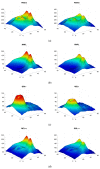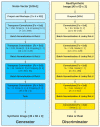Early Diagnosis of Multiple Sclerosis Using Swept-Source Optical Coherence Tomography and Convolutional Neural Networks Trained with Data Augmentation
- PMID: 35009710
- PMCID: PMC8747672
- DOI: 10.3390/s22010167
Early Diagnosis of Multiple Sclerosis Using Swept-Source Optical Coherence Tomography and Convolutional Neural Networks Trained with Data Augmentation
Abstract
Background: The aim of this paper is to implement a system to facilitate the diagnosis of multiple sclerosis (MS) in its initial stages. It does so using a convolutional neural network (CNN) to classify images captured with swept-source optical coherence tomography (SS-OCT).
Methods: SS-OCT images from 48 control subjects and 48 recently diagnosed MS patients have been used. These images show the thicknesses (45 × 60 points) of the following structures: complete retina, retinal nerve fiber layer, two ganglion cell layers (GCL+, GCL++) and choroid. The Cohen distance is used to identify the structures and the regions within them with greatest discriminant capacity. The original database of OCT images is augmented by a deep convolutional generative adversarial network to expand the CNN's training set.
Results: The retinal structures with greatest discriminant capacity are the GCL++ (44.99% of image points), complete retina (26.71%) and GCL+ (22.93%). Thresholding these images and using them as inputs to a CNN comprising two convolution modules and one classification module obtains sensitivity = specificity = 1.0.
Conclusions: Feature pre-selection and the use of a convolutional neural network may be a promising, nonharmful, low-cost, easy-to-perform and effective means of assisting the early diagnosis of MS based on SS-OCT thickness data.
Keywords: convolutional neural network; generative adversarial network; multiple sclerosis; optical coherence tomography.
Conflict of interest statement
The authors declare no conflict of interest. The funders had no role in the design of the study; in the collection, analyses, or interpretation of data; in the writing of the manuscript, or in the decision to publish the results.
Figures












Similar articles
-
Early diagnosis of multiple sclerosis by OCT analysis using Cohen's d method and a neural network as classifier.Comput Biol Med. 2021 Feb;129:104165. doi: 10.1016/j.compbiomed.2020.104165. Epub 2020 Dec 3. Comput Biol Med. 2021. PMID: 33302162
-
Computer-Aided Diagnosis of Multiple Sclerosis Using a Support Vector Machine and Optical Coherence Tomography Features.Sensors (Basel). 2019 Dec 3;19(23):5323. doi: 10.3390/s19235323. Sensors (Basel). 2019. PMID: 31816925 Free PMC article.
-
Diagnosis of multiple sclerosis using optical coherence tomography supported by artificial intelligence.Mult Scler Relat Disord. 2023 Jun;74:104725. doi: 10.1016/j.msard.2023.104725. Epub 2023 Apr 17. Mult Scler Relat Disord. 2023. PMID: 37086637
-
Advancing glaucoma detection with convolutional neural networks: a paradigm shift in ophthalmology.Rom J Ophthalmol. 2023 Jul-Sep;67(3):222-237. doi: 10.22336/rjo.2023.39. Rom J Ophthalmol. 2023. PMID: 37876506 Free PMC article. Review.
-
OCT and OCT-A biomarkers in multiple sclerosis - review.Rom J Ophthalmol. 2023 Apr-Jun;67(2):107-110. doi: 10.22336/rjo.2023.20. Rom J Ophthalmol. 2023. PMID: 37522023 Free PMC article. Review.
Cited by
-
Application of Deep Learning to Retinal-Image-Based Oculomics for Evaluation of Systemic Health: A Review.J Clin Med. 2022 Dec 24;12(1):152. doi: 10.3390/jcm12010152. J Clin Med. 2022. PMID: 36614953 Free PMC article. Review.
-
Deep learning in optical coherence tomography: Where are the gaps?Clin Exp Ophthalmol. 2023 Nov;51(8):853-863. doi: 10.1111/ceo.14258. Epub 2023 May 28. Clin Exp Ophthalmol. 2023. PMID: 37245525 Free PMC article. Review.
-
New Method of Early RRMS Diagnosis Using OCT-Assessed Structural Retinal Data and Explainable Artificial Intelligence.Transl Vis Sci Technol. 2025 Feb 3;14(2):14. doi: 10.1167/tvst.14.2.14. Transl Vis Sci Technol. 2025. PMID: 39928305 Free PMC article.
-
Optical Coherence Tomography and Optical Coherence Tomography with Angiography in Multiple Sclerosis.Healthcare (Basel). 2022 Jul 25;10(8):1386. doi: 10.3390/healthcare10081386. Healthcare (Basel). 2022. PMID: 35893208 Free PMC article. Review.
-
SLO-Net: Enhancing Multiple Sclerosis Diagnosis Beyond Optical Coherence Tomography Using Infrared Reflectance Scanning Laser Ophthalmoscopy Images.Transl Vis Sci Technol. 2024 Jul 1;13(7):13. doi: 10.1167/tvst.13.7.13. Transl Vis Sci Technol. 2024. PMID: 39017629 Free PMC article.
References
-
- Ker J., Wang L., Rao J., Lim T. Deep Learning Applications in Medical Image Analysis. IEEE Access. 2018;6:9375–9389. doi: 10.1109/ACCESS.2017.2788044. - DOI
-
- Salem M., Valverde S., Cabezas M., Pareto D., Oliver A., Salvi J., Rovira A., Llado X. Multiple Sclerosis Lesion Synthesis in MRI Using an Encoder-Decoder U-NET. IEEE Access. 2019;7:25171–25184. doi: 10.1109/ACCESS.2019.2900198. - DOI
-
- McKinley R., Wepfer R., Grunder L., Aschwanden F., Fischer T., Friedli C., Muri R., Rummel C., Verma R., Weisstanner C., et al. Automatic detection of lesion load change in Multiple Sclerosis using convolutional neural networks with segmentation confidence. NeuroImage Clin. 2020;25:102104. doi: 10.1016/j.nicl.2019.102104. - DOI - PMC - PubMed
MeSH terms
LinkOut - more resources
Full Text Sources
Medical

